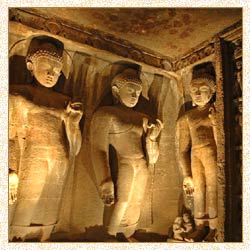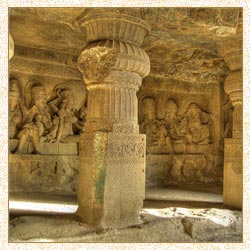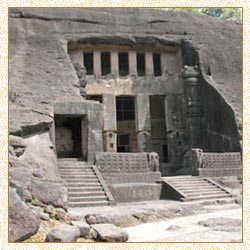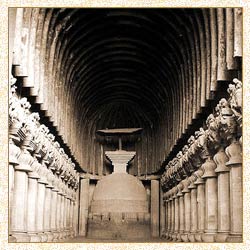Buddhist Caves in Maharashtra
The state of Maharashtra in India is
dotted with numerous Buddhist caves. Along with Buddhism, these caves
are also closely associated with other religions such as Hinduism and
Jainism. Some of these Buddhist cave in Maharashtra are Ajanta, Ellora,
Junnar, Karle, Kanheri and Bhaja. Of all the Buddhist caves in
Maharashtra, Ajanta and Ellora caves are most famous and World heritage
sites as they represent one of the masterpieces of sculpture and
paintings.
Ajanta Caves
The Ajanta caves are situated in the Aurangabad district of Maharashtra, India. The caves, thirty in number, are said to have witnessed the prosperity as well as the decline of the two sects of Buddhism, the Hinayana and the Mahayana. They are adorned with paintings, scriptures and architecture of both the sects.
Ellora Caves
Ellora Caves are situated in the state of Maharashtra, India. They lie at a distance of approximately 25 km from the Aurangabad district. The beautiful caves of Ellora symbolize three of the major religions of the world, namely Buddhism, Hinduism and Jainism. They also hold the distinction of being declared a World Heritage Site by UNESCO.
Junnar Caves
Junnar caves are situated in the Aurangabad district of Maharashtra. They lie at a distance of approximately 177 km from the city of Mumbai, on the Mumbai-Aurangabad route. There are three major groups of caves in the hills surrounding Junnar plains, of which the most prominent ones are Tulija Lena and the Ganesh Lena. All of the Junnar caves, situated in India, were founded somewhere between 2nd Century BC and 3rd Century AD.
Kanheri Caves
Kanheri Caves are situated in the heart of the Sanjay Gandhi National Park, Maharashtra. They lie at a distance of approximately 10 km from Borivali, Mumbai. They are almost 109 in number and date back to somewhere between 1st century BC and 9th century AD. Kanheri Caves signify a golden beginning and the end of Buddhism in the northern India.
Karla Caves
Karla Caves are situated in the state of Maharashtra, near the Pune-Mumbai Road. They lie at a distance of approximately 20 km from Lonavla and 40 km from Pune. The caves of Karla date back to the 2nd century BC and are known for their Chaitya Hall, intricate sculptures and pillars with ingenious architecture.
Ajanta Caves
The Ajanta caves are situated in the Aurangabad district of Maharashtra, India. The caves, thirty in number, are said to have witnessed the prosperity as well as the decline of the two sects of Buddhism, the Hinayana and the Mahayana. They are adorned with paintings, scriptures and architecture of both the sects.
Ellora Caves
Ellora Caves are situated in the state of Maharashtra, India. They lie at a distance of approximately 25 km from the Aurangabad district. The beautiful caves of Ellora symbolize three of the major religions of the world, namely Buddhism, Hinduism and Jainism. They also hold the distinction of being declared a World Heritage Site by UNESCO.
Junnar Caves
Junnar caves are situated in the Aurangabad district of Maharashtra. They lie at a distance of approximately 177 km from the city of Mumbai, on the Mumbai-Aurangabad route. There are three major groups of caves in the hills surrounding Junnar plains, of which the most prominent ones are Tulija Lena and the Ganesh Lena. All of the Junnar caves, situated in India, were founded somewhere between 2nd Century BC and 3rd Century AD.
Kanheri Caves
Kanheri Caves are situated in the heart of the Sanjay Gandhi National Park, Maharashtra. They lie at a distance of approximately 10 km from Borivali, Mumbai. They are almost 109 in number and date back to somewhere between 1st century BC and 9th century AD. Kanheri Caves signify a golden beginning and the end of Buddhism in the northern India.
Karla Caves
Karla Caves are situated in the state of Maharashtra, near the Pune-Mumbai Road. They lie at a distance of approximately 20 km from Lonavla and 40 km from Pune. The caves of Karla date back to the 2nd century BC and are known for their Chaitya Hall, intricate sculptures and pillars with ingenious architecture.
Ajanta Caves
| Location: | Aurangabad District, Maharashtra |
| Highlights: | UNESCO World Heritage Site |
| Represent: | Hinayana and the Mahayana sects of Buddhism |
The Ajanta caves are situated in the
Aurangabad district of Maharashtra, India. The caves, thirty in number,
are said to have witnessed the prosperity as well as the decline of the
two sects of Buddhism, the Hinayana and the Mahayana. They are adorned
with paintings, scriptures and architecture of both the sects. The
Ajanta caves served as the residence of the Buddhist monks and religious
devotees for more than 800 years. Today, these caves hold the
distinction of being declared a World Heritage Site by UNESCO.
 Ajanta
Caves signify the transition from the Hinayana sect of Buddhism to the
Mahayana sect of Buddhism. The Hinayana sect made use of the stupas and
other rock forms to represent Buddha. On the other hand, Mahayana sect
used idols. Cave number 8, 9, 10, 12, 13 and 15 belong to Hinayana, the
older sect. While, those of number 1, 2, 16, 17, 19 and 26 are related
to Mahayana sect. The 19th and 26th caves are Chaityas. Some of the
caves have not been finished till date.
Ajanta
Caves signify the transition from the Hinayana sect of Buddhism to the
Mahayana sect of Buddhism. The Hinayana sect made use of the stupas and
other rock forms to represent Buddha. On the other hand, Mahayana sect
used idols. Cave number 8, 9, 10, 12, 13 and 15 belong to Hinayana, the
older sect. While, those of number 1, 2, 16, 17, 19 and 26 are related
to Mahayana sect. The 19th and 26th caves are Chaityas. Some of the
caves have not been finished till date.
Cave number nine, ten, twelve and thirteen were prepared in the first phase and date back to somewhere between 2nd century BC and 1st century BC. Cave number nine and ten comprise of the Chaitya Halls or shrines. Cave number twelve and thirteen basically served as viharas or monasteries. The second phase came up with cave number one to seven, eleven and forteen to twenty-nine. All of these caves date back to somewhere between 5th century AD to 6th century AD.
Cave number nineteen, twenty six and twenty-nine comprise of Chaitya Halls or shrines. While, cave number one to seven, eleven, fourteen to eighteen, twenty to twenty-five, twenty-seven and twenty-eight are viharas or monasteries. Cave number two, three, five, eight, twenty-three to twenty-five and twenty-eight are still unfinished. Many caves are adorned with sculptures depict Buddha preaching in a sitting position.
How to reach Ajanta Caves
By Air
The nearest airport of Aurangabad is approximately 108 km away.
By Rail
Apart from Aurangabad, one can also go to the Jalgaon railway station, approximately 58 km away.
By Road
Ajanta Caves are well linked to Mumbai by road. Bus services are easily available.
 Ajanta
Caves signify the transition from the Hinayana sect of Buddhism to the
Mahayana sect of Buddhism. The Hinayana sect made use of the stupas and
other rock forms to represent Buddha. On the other hand, Mahayana sect
used idols. Cave number 8, 9, 10, 12, 13 and 15 belong to Hinayana, the
older sect. While, those of number 1, 2, 16, 17, 19 and 26 are related
to Mahayana sect. The 19th and 26th caves are Chaityas. Some of the
caves have not been finished till date.
Ajanta
Caves signify the transition from the Hinayana sect of Buddhism to the
Mahayana sect of Buddhism. The Hinayana sect made use of the stupas and
other rock forms to represent Buddha. On the other hand, Mahayana sect
used idols. Cave number 8, 9, 10, 12, 13 and 15 belong to Hinayana, the
older sect. While, those of number 1, 2, 16, 17, 19 and 26 are related
to Mahayana sect. The 19th and 26th caves are Chaityas. Some of the
caves have not been finished till date. Cave number nine, ten, twelve and thirteen were prepared in the first phase and date back to somewhere between 2nd century BC and 1st century BC. Cave number nine and ten comprise of the Chaitya Halls or shrines. Cave number twelve and thirteen basically served as viharas or monasteries. The second phase came up with cave number one to seven, eleven and forteen to twenty-nine. All of these caves date back to somewhere between 5th century AD to 6th century AD.
Cave number nineteen, twenty six and twenty-nine comprise of Chaitya Halls or shrines. While, cave number one to seven, eleven, fourteen to eighteen, twenty to twenty-five, twenty-seven and twenty-eight are viharas or monasteries. Cave number two, three, five, eight, twenty-three to twenty-five and twenty-eight are still unfinished. Many caves are adorned with sculptures depict Buddha preaching in a sitting position.
How to reach Ajanta Caves
By Air
The nearest airport of Aurangabad is approximately 108 km away.
By Rail
Apart from Aurangabad, one can also go to the Jalgaon railway station, approximately 58 km away.
By Road
Ajanta Caves are well linked to Mumbai by road. Bus services are easily available.
| Near Aurangabad district, Maharashtra | |
| Highlights: | UNESCO World Heritage Site |
| Represent: | Buddhism, Hinduism and Jainism |
| Founded In: | Between 5th century AD and 11th century AD |
Ellora Caves are situated in the
state of Maharashtra, India. They lie at a distance of approximately 25
km from the Aurangabad district. The beautiful caves of Ellora symbolize
three of the major religions of the world, namely Buddhism, Hinduism and
Jainism. They also hold the distinction of being declared a World
Heritage Site by UNESCO. Ellora Caves, cut out of the vertical face of a
cliff, comprise of splendid chaityas (halls of worship), viharas
(monasteries) and Hindu and Jain temples.
 There
are a total of 34 monasteries and temples inside these caves. All of
them date back to somewhere between 5th century AD and 11th century AD
and have been built in a linear pattern. All the caves have different
religious inclinations. Twelve of the caves (cave number 1 to 12) belong
to the Mahayana sect of Buddhism and were built between 550 AD and 750
AD. Seventeen caves (cave number 13 to 29) comprise of Hindu temples and
were constructed between 600 AD and 875 AD.
There
are a total of 34 monasteries and temples inside these caves. All of
them date back to somewhere between 5th century AD and 11th century AD
and have been built in a linear pattern. All the caves have different
religious inclinations. Twelve of the caves (cave number 1 to 12) belong
to the Mahayana sect of Buddhism and were built between 550 AD and 750
AD. Seventeen caves (cave number 13 to 29) comprise of Hindu temples and
were constructed between 600 AD and 875 AD.
Five caves (cave number 30 to 34) belong to the Jains and were built between 800 AD and 1000 AD. Some time back, archaeologists unearthed 22 more caves at Ellora, devoted to Lord Shiva, a Hindu God. All the caves are adorned with magnificent paintings and sculptures. The Buddhist caves have beautiful carvings that illustrate the life of Lord Buddha. Some of the caves have exquisite carvings and sculptures and have been based on the classical Indian art. Then, you have the Kailash Temple in cave number 16, deemed to be the largest monolith structure in the entire world.
Tourists come from far and wide to visit this amazing cave temple. Out of the numerous Buddhist Caves at Ellora, cave number 10, cave number 11 and cave number 12 are considered to be the most significant ones. Cave number 10 is a splendid example of Chaitya architecture in India. It is named after Vishwakarma, the presiding deity of all architects. Cave number 11 is known as Do Tal. It is a three-story structure dating back to the 8th century AD. Cave number 12, known by the name of Teen Tal, is also a wonderful three-story cave.
How to Reach Ellora Caves
By Air
The nearest airport of Aurangabad is approximately 30 km away.
By Rail
Apart from Aurangabad railway station, one can also go to the Jalgaon railway station.
By Road
Ellora Caves are well linked to Aurangabad by road. Buses as well taxis are easily available.
 There
are a total of 34 monasteries and temples inside these caves. All of
them date back to somewhere between 5th century AD and 11th century AD
and have been built in a linear pattern. All the caves have different
religious inclinations. Twelve of the caves (cave number 1 to 12) belong
to the Mahayana sect of Buddhism and were built between 550 AD and 750
AD. Seventeen caves (cave number 13 to 29) comprise of Hindu temples and
were constructed between 600 AD and 875 AD.
There
are a total of 34 monasteries and temples inside these caves. All of
them date back to somewhere between 5th century AD and 11th century AD
and have been built in a linear pattern. All the caves have different
religious inclinations. Twelve of the caves (cave number 1 to 12) belong
to the Mahayana sect of Buddhism and were built between 550 AD and 750
AD. Seventeen caves (cave number 13 to 29) comprise of Hindu temples and
were constructed between 600 AD and 875 AD. Five caves (cave number 30 to 34) belong to the Jains and were built between 800 AD and 1000 AD. Some time back, archaeologists unearthed 22 more caves at Ellora, devoted to Lord Shiva, a Hindu God. All the caves are adorned with magnificent paintings and sculptures. The Buddhist caves have beautiful carvings that illustrate the life of Lord Buddha. Some of the caves have exquisite carvings and sculptures and have been based on the classical Indian art. Then, you have the Kailash Temple in cave number 16, deemed to be the largest monolith structure in the entire world.
Tourists come from far and wide to visit this amazing cave temple. Out of the numerous Buddhist Caves at Ellora, cave number 10, cave number 11 and cave number 12 are considered to be the most significant ones. Cave number 10 is a splendid example of Chaitya architecture in India. It is named after Vishwakarma, the presiding deity of all architects. Cave number 11 is known as Do Tal. It is a three-story structure dating back to the 8th century AD. Cave number 12, known by the name of Teen Tal, is also a wonderful three-story cave.
How to Reach Ellora Caves
By Air
The nearest airport of Aurangabad is approximately 30 km away.
By Rail
Apart from Aurangabad railway station, one can also go to the Jalgaon railway station.
By Road
Ellora Caves are well linked to Aurangabad by road. Buses as well taxis are easily available.
Junnar Caves
| Location: | Approximately 177 km from Mumbai |
| Founded In: | 2nd Century BC to 3rd Century AD |
Junnar caves are situated in the
Aurangabad district of Maharashtra. They lie at a distance of
approximately 177 km from the city of Mumbai, on the Mumbai-Aurangabad
route. There are three major groups of caves in the hills surrounding
Junnar plains, of which the most prominent ones are Tulija Lena and the
Ganesh Lena. All of the Junnar caves, situated in India, were founded
somewhere between 2nd Century BC and 3rd Century AD.
The first group of caves, the Tulija Lena, consists of the Chaitya hall, adorned with a circular dome ceiling. The second group is situated near the Manmodi hills is archaeologically quite significant. Archaeologists visit these caves on a frequent basis, to testify the sculptures and images in the caves. The third group of caves, known as Ganesh Lena, is approximately 4 km to the south of Junnar. This group consists of a number of small cells and viharas, with most popular ones being the Chaitya Cave No. 6 and the Ganesh Lena Vihara.
How to reach Junnar Caves
By Air
The nearest airport from Junnar is at Mumbai, approximately 177 km away.
By Rail
The nearest railway station is also that of Mumbai, which is well connected with all the key cities.
By Road
Junnar caves lie on the Mumbai-Aurangabad route and are regularly serviced by coaches, buses and private taxis.
The first group of caves, the Tulija Lena, consists of the Chaitya hall, adorned with a circular dome ceiling. The second group is situated near the Manmodi hills is archaeologically quite significant. Archaeologists visit these caves on a frequent basis, to testify the sculptures and images in the caves. The third group of caves, known as Ganesh Lena, is approximately 4 km to the south of Junnar. This group consists of a number of small cells and viharas, with most popular ones being the Chaitya Cave No. 6 and the Ganesh Lena Vihara.
How to reach Junnar Caves
By Air
The nearest airport from Junnar is at Mumbai, approximately 177 km away.
By Rail
The nearest railway station is also that of Mumbai, which is well connected with all the key cities.
By Road
Junnar caves lie on the Mumbai-Aurangabad route and are regularly serviced by coaches, buses and private taxis.
Kanheri Caves
| Location: | Approximately 10 km from Borivali, Mumbai |
| Founded In: | 1st century BC to 9th century AD |
 Kanheri
Caves are situated in the heart of the Sanjay Gandhi National Park,
Maharashtra. They lie at a distance of approximately 10 km from
Borivali, Mumbai. They are almost 109 in number and date back to
somewhere between 1st century BC and 9th century AD. Kanheri Caves
signify a golden beginning and the end of Buddhism in the northern
India. Buddhist Monks as well as traders, who traveled for religious
favors, used to make use of these caves on a frequent basis.
Kanheri
Caves are situated in the heart of the Sanjay Gandhi National Park,
Maharashtra. They lie at a distance of approximately 10 km from
Borivali, Mumbai. They are almost 109 in number and date back to
somewhere between 1st century BC and 9th century AD. Kanheri Caves
signify a golden beginning and the end of Buddhism in the northern
India. Buddhist Monks as well as traders, who traveled for religious
favors, used to make use of these caves on a frequent basis. At the top of the caves stand exquisite sculptures of goddess Tara and Goddess Bhrukti. The central structure is that of Avalokiteswara, with five symbols, each in the right as well as the left. Another major attraction of Kanheri Caves is the Chaitya Cave, dating back to somewhere between 4th century AD and 5th century AD. Magnificent decorative woodwork embellishes the roof of this cave. The outer sides of the wall are adorned with sculptured statues of Buddha, mainly the Avalokiteswara incarnation.
How to reach Kanheri Caves
By Air
The nearest airport is that of Mumbai.
By Rail
The Borivali railway station is the nearest. However, one may go to the Chatrapati Shivaji Terminus also, which is well connected with all the major cities of India.
By Road
One can easily get bus services from Mumbai.
Nearby Cities
Mumbai: Approximately 45 km
Karla Caves
| Location: | Karla, approximately 20 km from Lonavla |
| Founded in: | 2nd Century BC |
| Significance: | Chaitya Hall, intricate sculptures and pillars |
 Karla
Caves are situated in the state of Maharashtra, near the Pune-Mumbai
Road. They lie at a distance of approximately 20 km from Lonavla and 40
km from Pune. The caves of Karla date back to the 2nd century BC and are
known for their Chaitya Hall, intricate sculptures and pillars with
ingenious architecture. Chaitya hall boasts of its amazing structural
design. The rooftop is built of teakwood and even the pillars have been
beautifully carved.
Karla
Caves are situated in the state of Maharashtra, near the Pune-Mumbai
Road. They lie at a distance of approximately 20 km from Lonavla and 40
km from Pune. The caves of Karla date back to the 2nd century BC and are
known for their Chaitya Hall, intricate sculptures and pillars with
ingenious architecture. Chaitya hall boasts of its amazing structural
design. The rooftop is built of teakwood and even the pillars have been
beautifully carved. One of the pillars of Karla Caves, with four lions at the top, now forms the national emblem of India. A number of sculptures cut out of rock, based on numerous animals as well as different forms of human life, adorn the caves of Karla. The other attractions include a stone stupa and 37 pillars, chiseled with the figures of prosperous men and women on elephants, prostrating before Lord Buddha. The bouncing sunshine falling inside the shrine further lends it a mystic as well as a tranquil aura.
How to reach Karla Caves
By Air
The nearest airport is that of Pune airport, situated at a distance of 55 km from Karla.
By Rail
The local railway station of Malavil is only 5 km away. Apart from that, there is the Pune railway station, well connected with all the major cities of India.
By Road
Buses plying between Pune and Mumbai go via Karla only. One can also hire private vehicles for the purpose.
Nearest Cities
Lonavala - Approximately 20 km
Pune - Approximately 40 km

Nice list of caves in Maharashtra . Caves represent one of the masterpieces of sculpture and paintings. It is also famous as historical places in Maharashtra.
ReplyDeleteAre you tired of seeking loans and Mortgages,have you been turned down constantly By your banks and other financial institutions,We offer any form of loan to individuals and corporate bodies at low interest rate.If you are interested in taking a loan,feel free to contact us today,we promise to offer you the best services ever.Just give us a try,because a trial will convince you.What are your Financial needs?Do you need a business loan?Do you need a personal loan?Do you want to buy a car?Do you want to refinance?Do you need a mortgage loan?Do you need a huge capital to start off your business proposal or expansion? Have you lost hope and you think there is no way out, and your financial burdens still persists? Contact us (gaincreditloan1@gmail.com)
ReplyDeleteYour Name:...............
Your Country:...............
Your Occupation:...............
Loan Amount Needed:...............
Loan Duration...............
Monthly Income:...............
Your Telephone Number:.....................
Business Plan/Use Of Your Loan:...............
Contact Us At : gaincreditloan1@gmail.com
Phone number :+44-7774-038335 (WhatsApp Only)